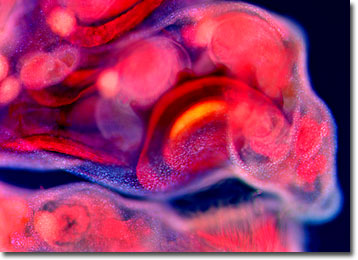Fluorescence Digital Image Gallery
Pectinatella Bryozoans
Bryozoans are sessile aquatic microorganisms that were believed to be plants until the mid-1700s. Though they have since been reclassified, the colonial creatures are still commonly referred to as moss animals.

Individual zooids, or separate members of a bryozoan colony, are very tiny, but the colonies may grow more than two feet in diameter. The shape of the colonies may, however, vary greatly in shape. Some branch upwards in a vertical manner while others may be flat and spread thinly over rocks or other plants. Most are found in marine environments, but one class of bryozoans, Phylactolaemata, exclusively inhabit fresh water bodies. Within this class is Pectinatella, a genus of bryozoans whose members often reside in North America. A relatively common species is P. magnifica, which grows larger than most other species, but has a less defined shape, appearing remarkably similar to a blob of jelly.
Colonies of Pectinatella species and other bryozoans increase rapidly in size, sometimes doubling in diameter over the course of a few days if proper conditions and abundant food are present. P. magnifica prefers warm temperatures and feeds on small aquatic plants and animals such as diatoms, algae, and bacteria. To do so, the zooids utilize specialized feeding structures known as lophophores that are ciliated and can be extended or retracted as needed. If the environment becomes unfavorable, however, perhaps due to the approach of winter, the colonies produce statoblasts, which are more able to withstand extreme conditions. The statoblasts are lined with hook-like structures that allow them to attach to passing creatures that often inadvertently transport them to different bodies of water.
BACK TO THE FLUORESCENCE DIGITAL IMAGE GALLERY
